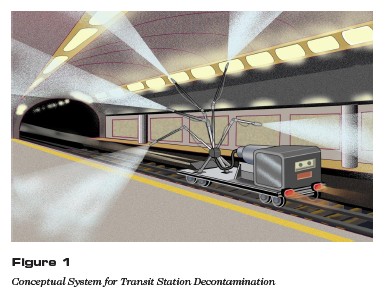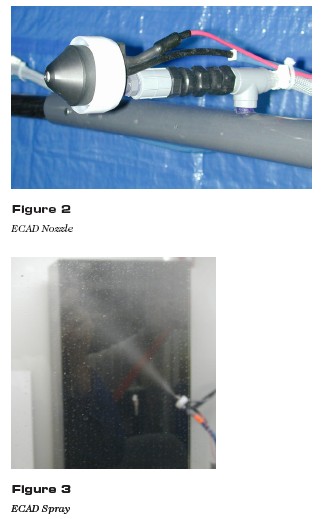|
This project explored a concept for a rapidly deployable decontamination system to restore rail transit facilities in the event of a chemical or biological agent release in a rail transit subway station. The system, as conceptually depicted in Figure 1, is conceived to utilize the existing rail transit system tracks to deliver an automated car using a unique decontamination system and expandable booms to reach various inaccessible areas in the station.
The heart of the system is the electrostatically charged aerosol decontamination (ECAD) capability conceived by Foster-Miller. Although this core technology has been demonstrated in a number of other applications, none has been as large, as complex, or as challenging as a rail transit station.
The basic concept is similar to one used for cleaning subway facilities today, but differs in configuration of the automated car and the unique decontamination delivery system. The car will carry the ECAD system that Foster-Miller first developed for the Army’s Chemical Demilitarization program.
The ECAD nozzles incorporated into the system both aerosolize and charge liquid droplets produced from any stored aqueous solution. The effect of this aerosolization and charging is a fine mist that is attracted to all surfaces, providing a coating of disinfectant on even hard-toget-at locations. In concert with the nozzles, the automated car is expected to be equipped with the necessary compressor, reagent storage, power conversion and related equipment. Also, as depicted in Figure 1, the system is envisioned to have extendable booms capable of being expanded and moved to deliver the reagent to remote, difficult-to-reach locations within the transit facility.
 
Completed Investigation
This project investigated the use of electrostatically charged aerosol decontamination (ECAD) to restore rail transit facilities in the event of a chemical or biological release. The application of this approach to a large, complex facility, such as a rail transit station and subway tunnel, presents a challenge to both the delivery system and the decontamination agent. This project addressed the critical initial stage development and validation of an automated delivery system (ECADS) in providing effective decontamination coverage in subway stations. Foster-Miller Inc. developed the requirements for a large-scale, automated system to provide subway station and subway tunnel decontamination, developed a concept model to meet those requirements, and conducted static tests at a selected Metrorail station to determine ECADS nozzle effectiveness in the transit facility environment and to identify performance enhancements. The Washington Metropolitan Area Transit Authority (WMATA) participated in this project by assisting in developing the requirements (needs statements) for such a system for Metrorail stations, provided technical guidance, and participated in the prototype testing in their transit system.
In addition to the delivery capability, another key element of the "system" is the decontaminant itself. Foster-Miller has utilized a number of "decontaminants" with the ECAD capability, including bleach-based reagents for chemical decontamination and unique biocides. Foster-Millerhas also looked into the use of other reagent systems.
The goal is to find the decontaminate that is effective against a variety of chemical and biological agents and is simultaneously safe to personnel, equipment, and facilities. Foster-Miller investigated a range of chemical and biological agents that are either commercially available or in development.
This project is divided into three main stages:
n Stage 1: Problem Definition and State-of-the-Art Assessment.
n Stage 2: Conceptual System Design.
n Stage 3: Validation Demonstration.
Product Payoff Potential
The sarin gas attack in the Tokyo subway system and the SARS infections in Toronto are ready reminders of the potential for transit system disruption. Although small portable units are available for use in transit rail car and transit bus disinfection, no such approach to deal with the complexities and size of transit subway stations and tunnels is currently available. Applying a capability first developed for the military to decontaminate a facility after a chemical or biological agent release will not only be effective in dealing with the contaminant, but will quickly restore service and rider confidence. Also important is the deterrent effect of having such a system available for quick restoration.
Product Transfer
This project evaluated the concept of a track-mounted decontamination capability that could be readily deployed in the event of a chemical or biological agent release. Follow-on work would be needed to develop a prototype system. The participation of WMATA in this project and the stated interest in the ECADS capability for transit decontamination and disinfection applications by other transit agencies and port authorities, such as Massachusetts Bay Transportation Authority (MBTA), South Eastern Pennsylvania Transportation Authority (SEPTA), and Port Authority Trans Hudson (PATH), will aid in the deployment of this system after it is evaluated.
The contractor's final report can be located at:
https://onlinepubs.trb.org/onlinepubs/archive/studies/idea/finalreports/transit/Transit45_Final_Report.pdf
|
|